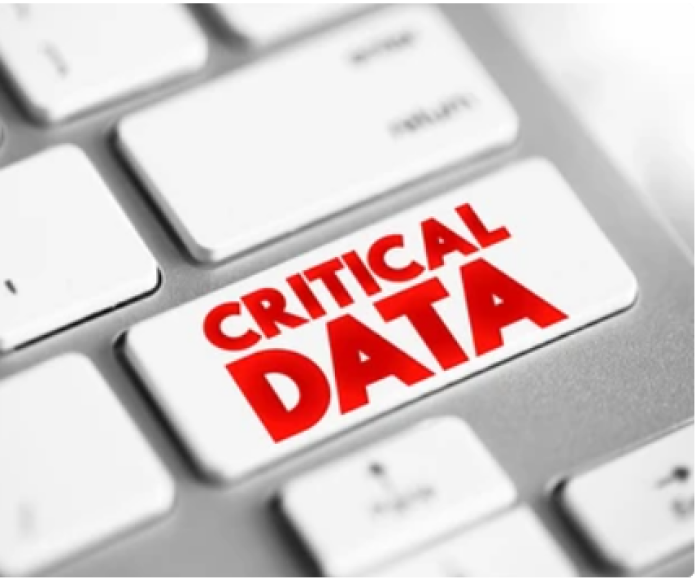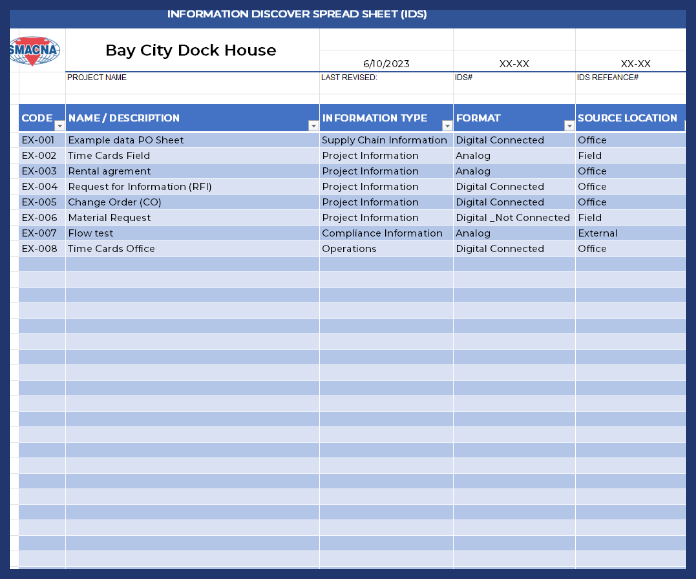Data Stewardship
Introduction
The purpose of this playbook section is to provide users with a clear understanding of where their business stands in terms of data stewardship. Data stewardship is a process that seeks to ensure that data is being used in a responsible, consistent, effective and efficient manner. This is the first section and is a necessary first step to be successful in implementing, using and maintaining technology.
In this section, we will be looking at how to collect and organize the critical information and data in your organization. This includes how to provide your company with guidance and clarity for its use, sharing, access, storage, and security.
By the end of this section, you will have produced a data and information planning document that can be used to both improve your organization's current data policies and maintain good stewardship moving forward.
The document, referred to as the Information Discovery Spreadsheet (IDS) is a first step in achieving good data and understanding how data is at work within your organization.
What Is Data?
In order to understand this playbook one of the things we have to have is a basic understanding of what data is. Put simply, data is information, but it is most often used to describe information that can be processed by a computer, also called digital or binary information. All of the files that your business uses, generates, and modifies, constitutes your available data. Your available information, however, would include all of the digital information, analog information, gauges, signs, written notes, forms and other information that is not binary and immediately accessible to computers or technology. In the next section we will be focusing on information that is not yet in a digital format as we look at how to digitize your organization and make that information available to your organization's technology.

Data is most often used to describe "information that can be processed by a computer."
The definition of data is often confused because of the general nature of the term. When people are asked about data, they often refer to forms or examples specific to their vocation. For instance, if we were to talk to someone in programming, they might define data in terms of program-related elements such as strings, booleans, characters, integers, and floating points. These are the five data forms central to programing. This tendency to use forms and examples of data as a definition is common, but can lead to a poor understanding of the scope of data within an organization.
The term "data" has often been associated with the notion of objective truth or reliability, suggesting that the information is based on a dependable source or methodology. However, this assumption is not accurate. The term data does not indicate the quality and accuracy of the information that it represents.
The reliability and accuracy of data fall under the domain of "Data Governance" and are often available for review, especially in the case of scientifically collected data. Determining the quality of the data being recorded within your organization, will be important to understanding how that data can be used and where it is likely to contain mistakes. Poor quality data containing errors, omissions and mistakes can have a large impact on businesses hoping to leverage data to direct discussions. This will be discussed further as we look at capturing critical information and data within your organization.
Collecting and Identifying Information / Data
Most sheet metal contractors generate an immense amount of information in their day-to-day process. This information takes the forms of files, emails, time cards, project specifications, drawings and a host of other sources. In this section we’ll look at how to take the information that is being generated by your business and collect it in a manner that allows it to be used to enhance and grow your company. This is the first step in preparing your company for digital transformation. In this section we will give guidance on how to turn analog information, like hand written notes and forms, into data. This is commonly referred to as “digitization” and is the foundation for the use of technology within a company. Becoming a mostly digital company is at the heart of what the beginning of this playbook hopes to accomplish, but to get there we are going to need a plan.
Data Collection Plan
 The first step to making a data collection plan, is performing a Discovery Survey to determine what critical information is being produced by your company, identifying it, and defining several key areas. It is important to note that this is an ongoing process and that critical information will change over time. For example, the purchase of new shop equipment or the implementation of any technology will likely require an update to the data collection plan. So, keeping the plan simple and easy to update is vital. For this reason, we have provided an Information Discovery Spreadsheet (IDS). It will help you capture critical information and to define key attributes about that information. It will also be used during digitization to organize and track information that is not currently available in a digital format.
The first step to making a data collection plan, is performing a Discovery Survey to determine what critical information is being produced by your company, identifying it, and defining several key areas. It is important to note that this is an ongoing process and that critical information will change over time. For example, the purchase of new shop equipment or the implementation of any technology will likely require an update to the data collection plan. So, keeping the plan simple and easy to update is vital. For this reason, we have provided an Information Discovery Spreadsheet (IDS). It will help you capture critical information and to define key attributes about that information. It will also be used during digitization to organize and track information that is not currently available in a digital format.
What Is Critical Information?
Critical information is the data that is essential for the functioning, continuity, and success of a business or business process. It is the information that, if lost or compromised, would significantly disrupt operations, impact profitability, violate compliance requirements, or damage the reputation of the company. Considering the large volume of information that businesses produce, it’s important to take a measured and systematic approach to determining the critical information within your company. Understand that each piece of information that is identified brings us closer to our goal, and that information that is missed during the initial survey can be added as it is identified. The use of the Information Discovery Spreadsheet (Included in this playbook), or a similar document to identify and categorize the critical information within your business, will be essential in the long-term success of your data plan.

Tool Tip: For more technical categories like file naming structure or file extension even storage location. You might consider using a file inspection software. “Everything” (https://www.voidtools.com/) it is a free light weight tool for indexing and displaying large volumes of files.
Hand On Learning
Information Discovery Sheet
This section focuses on data stewardship, uses the information discovery sheet (IDS) to guide you through understanding data stewardship in a interactive way. The IDs is a tool that captures the critical information in a company or project and help organize and maintain standards for that information. It does this by identifying important properties of that information.

Properties of Data and the IDs
Below we walk through each area of information addressed in the IDS and providing best practices within those areas. It is important to remember to capture the current state (as-is) during the initial discovery survey of the information in your organization. This section will go through each attribute of the information and direct you to best practices providing you with a systematic way to improve the level of data stewardship within your company.
The IDS will also be used in the digitization section to help us identify information that is critical to processes and procedures but not yet digitized. With that in mind, it may save time to focus on information that is already digital in nature as you're going through this section.
Even if you do not fill out an IDS understanding each of the properties give you a systematic way to understand and better manage the data within your company.

